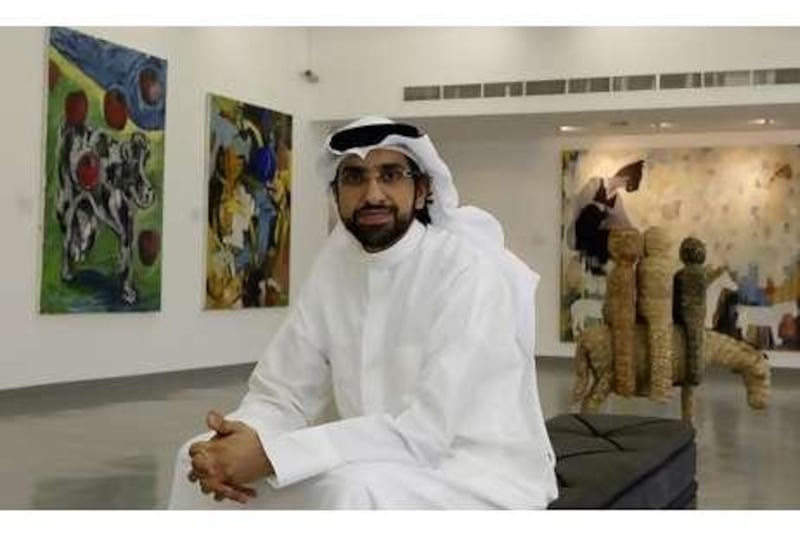SHARJAH // Gesturing to a bronze statue of Umm Kulthum, the Egyptian singer, Sheikh Sultan Sooud Al Qassemi remarks: "This should be in the middle of a square in Cairo, not here in a gallery in Sharjah." The statue is one of 32 pieces carefully selected from Sheikh Sultan's personal collection of almost 500 paintings, photographs, sculptures and installations by Arab artists.
It forms part of the inaugural exhibition of the Barjeel Art Foundation in Sharjah, which Sheikh Sultan established at the beginning of the year to showcase the work of contemporary Arab artists. Sheikh Sultan is well known for championing emerging talent in the Middle East. Work by well-known artists is displayed side-by-side with those yet to be discovered. A bronzework, Umm Kulthum 2, by Adam Henein, renowned as one of the Arab world's leading sculptors, stands alongside a striking painting of a school class whose city is exploding behind them by Jeffar Khaldi, a Palestinian artist who is now based in Dubai.
"This is a homage to the children who lost their lives in the Gaza war which started in December 2008," Sheikh Sultan says of an acrylic painting entitled Special Report. It is current, contemporary. It tells part of the story of the Arab world." Sheikh Sultan can tell a story about each piece in the exhibition, entitled Peripheral Vision. "The idea was to find the story of the Arab world and tell it through the foundation," he says.
It has taken more than 10 years for Sheikh Sultan, the co-founder of Meem Gallery in Dubai, non-resident Fellow at the Dubai School of Government and a weekly columnist with The National, to gather the collection, which will be presented through rotating public exhibitions in the space at the Maraya Art Centre in Al Qasba. They are not for sale. Sheikh Sultan offers them on loan to other galleries and international institutions, asking only for insurance and transportation costs to be covered in return.
"What's the point in art if it is not shared?" he says. "There are so many collectors in the UAE, but they keep their collections private. "Artists are the conscience of society. It is essential for their work to be seen and appreciated." Mandy Merzaben, the gallery manager, says the cultural value of art is increased through exhibitions. "When people come, they offer their own perspective and opinion, adding to our experience of the works," says Miss Merzaben, 23.
"It deepens our understanding. This is the value of sharing art." Foundations such as Barjeel are vital to the region, says Bashar al Shroogi, director of Cuadro Fine Art Gallery in Dubai. "They complete what we can't do as commercial galleries. Until contemporary art museums open doors we rely on foundations to identify new talent. " Manal al Dowayan, a Saudi photographer and artist, who is currently in Dubai completing a three-month residency, has two photographs from her Landscape of the Mind collection on display in the Barjeel space.
"This is big for me," she says. "I've exhibited in London and Berlin but to be part of a collection regionally is very important. "Local support is needed and it is very rare. It gives art like mine a place in the history of the region." Ms al Dowayan's black and white photographs explore contradictions within Saudi society. All pieces in the exhibition were made after 2007. Eight Emirati artists are featured in the show, which includes a three-by-two-metre photograph by Reem al Ghaith showing a framed photograph of the Bastakiya district of old Dubai, on the beach in front of one of The Palm developments, and a satirical image of a cow and tomatoes, called After Press Conference by Hassan Sharif.
There is also a work by Layan Shawabkeh, a young Palestinian artist whose work has been compared to Picasso's early work. And who died aged 23 from cancer in December of last year. Since the exhibition opened, the Institute for Foreign Cultural Relations in Berlin and Stuttgart has requested a piece for two shows next year, and next month one piece will be displayed in the International Festival of Asila, an annual arts event in Morocco. @Email:aseaman@thenational.ae






